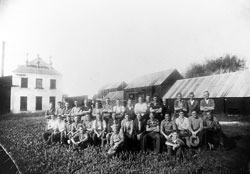
Chatswood, 1983.
Courtesy The Chaffer Group
The rural district of Willoughby on the north shore provided an attractive alternative for Sydney’s tanners. It had creeks with a regular supply of water, wattlebark was readily available and there was plenty of cheap land in bushland that did not impinge on residential areas.
James Forsyth, a leather dresser and dyer by trade and proprietor of a leather business in the city, purchased land at Willoughby in 1869 and established the pioneer Willoughby tannery on Sugarloaf Creek in 1869. His sons, Thomas Todd Forsyth and Robert managed the business, which they called the Rosewall Tannery. It was the first of 16 tanneries, but the subsequent establishments were clustered in the area known as ‘The Hollow’ or ‘The Vale’ through which Scotts Creek flows.
The Enterprises

Illustrate Sydney News
Willoughby Museum collection.
Working in the Tanneries

Willoughby Museum collection
Harry Fox joined his father working at Bugden’s Progressive tannery in 1950. He recalls:
It was hard work there. There were 20-25 employees there at this time and our hours were from 7.30am to 5pm. I recall everything in the factory was worked by steam. I was a general hand and therefore I was allocated tasks each morning. I was often allocated to work at the ‘Spender’ (tanning pits). They were filled with water and we would grind wattle bark and add it to the water to extract the tannins. The water was then pumped off to tan the hides and we would have to dig out the wattle bark residue, which was sold to nurseries, etc for use as plant fertilizer. I worked there for around two years.3
The Tannery Community
With the concentration of tanneries along Scotts Creek, Willoughby’s tanners became a close-knit community of like-minded people. They and their workers lived near their business enterprises and their lives were interwoven, sometimes by marriage.

two of his young sons in 1904.
Courtesy The Chaffer Group

with employees in the grounds.
Willoughby Museum collection
A number of Willoughby tanners were members of the NSW Master Tanners’ Association and its conferences were hosted in Willoughby on several occasions. The owners were strong protectionists and sought government action to restrict imported leather goods. They also had a faith in the ‘cleanliness’ of their industry and mounted strong political campaigns against attempts by governments to impose pollution controls on their industry. They were successful in blocking attempts to bring tanneries under the Noxious Trades Act in 1907, but in 1940 tanning was declared a noxious trade. Suburbia had finally caught up with the Willoughby tanneries and community concerns about pollution along Scotts Creek brought pressure for their closure.
Most tanneries had closed by 1965, but two continued operations. When W Chaffer & Sons had their plans for major building alterations rejected by Willoughby Council in 1983, it decided to move to new premises in Kingsgrove and the Chatswood premises were vacated by August 1985. The smaller firm of L Wilson & Son continued operations until 1988.
1 Wikipedia, http://en.wikipedia.org/wiki/Tanning
2 Leslie, Esther, Willoughby: the suburb and its people. Chatswood, Willoughby Municipal Council, 1988, p. 116.
3 Harry Fox, interview at Castlecrag, 17 May 2011
